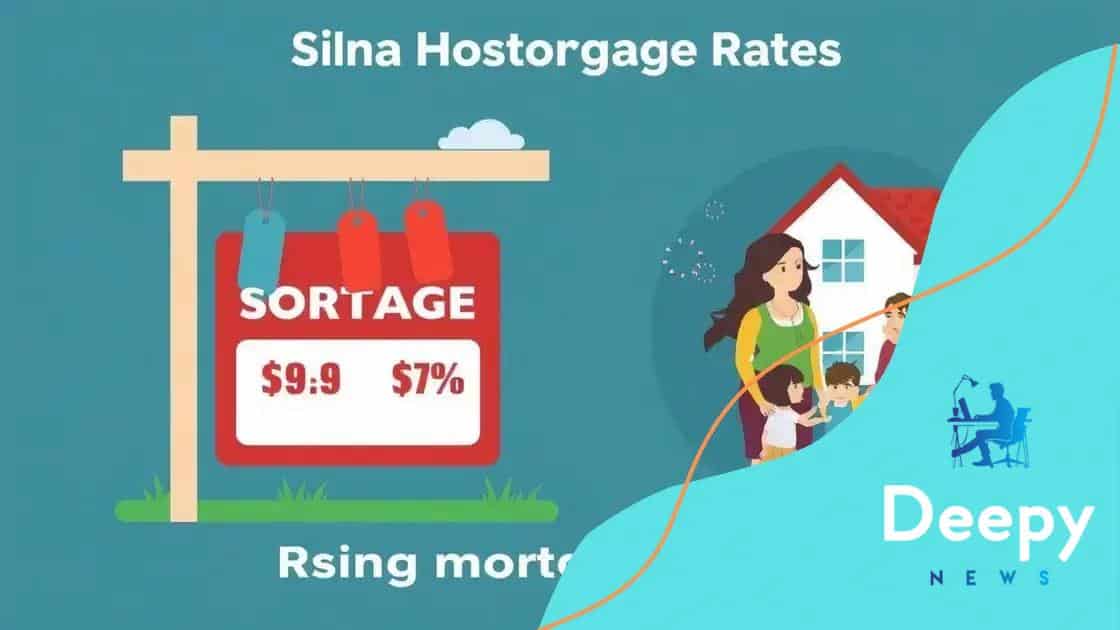Fed explores rate hikes: what it means for you

The Fed explores rate hikes, which directly influences borrowing costs, mortgage rates, and investment strategies, making it crucial for consumers and investors to stay informed and adapt to economic changes.
The Fed explores rate hikes and its potential impact on our daily lives. Have you wondered how these changes might affect your wallet or investments? Let’s dive into the implications.
Understanding the current economic landscape
Understanding the current economic landscape is vital for making informed decisions, especially as the Fed explores rate hikes. The economy is constantly shifting, influenced by various factors that can affect everyone, from homeowners to investors.
One major factor is the Federal Reserve’s interest rate decisions. These rates can shape the financial environment, leading to changes in borrowing costs and consumer spending behavior. When the Fed raises rates, it often signals a stronger economy, but it can also mean that people will pay more for loans.
Key Indicators to Watch
As one navigates through economic news, it’s important to focus on some key indicators:
- Inflation rates – These indicate how much prices for goods and services are rising.
- Employment figures – A strong job market often correlates with economic strength.
- Consumer confidence – This signals how willing people are to spend money.
- GDP growth – A higher gross domestic product shows an expanding economy.
Moreover, external influences like global trade dynamics and geopolitical tensions can also impact the economic landscape. When trade agreements change or conflict arises, these events create ripples felt in local markets. For example, shifts in oil prices can influence transportation costs, which cascade into consumer goods pricing, affecting all of us.
Keeping an Eye on Market Trends
Investors should also pay attention to market trends driven by these economic factors. For instance, rising interest rates might lead to declines in stock prices as borrowing costs increase for companies, potentially impacting their profitability. Therefore, understanding how these elements interact can aid in making better investment choices.
The current economic landscape is complex and ever-evolving. Staying informed on key trends and indicators allows individuals to adapt their strategies—whether that means adjusting their spending habits, refinancing loans, or reconsidering their investment portfolios. With the Fed’s outlook influencing many aspects of the economy, remaining knowledgeable can lead to better financial outcomes.
How rate hikes influence consumer spending
When discussing how rate hikes influence consumer spending, it’s essential to understand the mechanics behind these changes. When the Federal Reserve increases interest rates, borrowing becomes more expensive. This situation can lead to a shift in consumer behavior, affecting various aspects of daily life.
Higher interest rates mean that loans for cars, homes, and even credit cards cost more. As consumers face higher monthly payments, many may choose to spend less on luxury items or dining out, focusing instead on necessities. This change in spending patterns can significantly impact the economy.
Effects on Major Consumer Purchases
Here are some ways that higher rates can influence major consumer purchases:
- Housing Market – With increased mortgage rates, potential homebuyers may delay purchases, slowing down the housing market.
- Automobile Sales – Consumers might hold off on buying new cars due to the higher loan costs, leading to reduced dealership sales.
- Credit Card Usage – Rising interest rates can discourage the use of credit cards since outstanding balances will incur more interest.
- Personal Loans – Borrowers may rethink personal loans for vacations or renovations, resulting in decreased overall spending.
The ripple effect of reduced consumer spending can lead to decreased business revenue. Companies may respond by cutting back on production or delaying expansions, potentially impacting job growth and the economy as a whole. This cycle demonstrates the interconnectedness of interest rates, consumer behavior, and economic health.
Adapting to Rate Changes
Consumers often adapt to these shifts by reassessing their budgets. Many might begin to prioritize essential expenses over discretionary spending. It’s common to see an increase in savings as families look for ways to cut costs. Understanding this adjustment can help individuals prepare for any future financial changes.
The relationship between rate hikes and consumer spending is complex, yet vital for anyone looking to navigate their financial landscape. As rates continue to rise or fall, consumers must stay informed and flexible, adjusting their spending habits accordingly to maintain financial health.
The impact of rate hikes on mortgage rates

The impact of rate hikes on mortgage rates is significant and can affect both current homeowners and prospective buyers. When the Federal Reserve raises interest rates, it often leads to increased borrowing costs across the board, including mortgages. This situation can result in higher monthly payments for new loans and can even influence existing homeowners looking to refinance or make changes.
Mortgage rates are closely tied to the overall interest rate environment. As the Fed increases rates, lenders tend to follow suit by raising their mortgage rates. This change means that prospective homebuyers may find themselves paying more to finance their new homes, which can lead to a slowdown in home purchases.
How Rate Hikes Affect Homeowners
For current homeowners, rate increases can impact various aspects:
- Refinancing Costs – Homeowners looking to refinance their mortgages may face higher rates, making it less attractive to switch loans.
- Home Equity Loans – With rising rates, the cost of borrowing against home equity increases as well.
- Market Value – Higher mortgage rates can slow down home sales, potentially affecting property values.
- Affordability Concerns – As monthly payments rise, some homeowners may struggle to afford their mortgages.
This increase in financial burdens can lead to fewer homes on the market, as homeowners choose to stay put rather than sell their properties. Consequently, this results in limited supply and possibly driving up prices even further due to demand.
Buyers in a Rising Rate Environment
For buyers, understanding the effect of rate hikes is crucial. Increased mortgage rates can lead to higher monthly payments, making homeownership less attainable for many. Buyers may need to adjust their budgets or reconsider their target homes. In some cases, individuals could opt for lower-priced homes or choose to wait until rates stabilize.
Moreover, the anticipation of further rate hikes can cause uncertainty in the housing market. Buyers may rush to purchase homes before rates increase again, potentially creating a temporary spike in demand. However, if rates continue to rise, this could result in a eventual downturn as affordability becomes a more significant issue.
Investment strategies during rate fluctuations
Investment strategies during rate fluctuations are essential for navigating a changing economic landscape. As the Federal Reserve adjusts interest rates, investors must rethink their approaches to ensure they effectively manage their portfolios. Understanding how these fluctuations impact different asset classes can help in making informed decisions.
When rates rise, the cost of borrowing increases. This can lead to shifts in consumer behavior and overall market dynamics, influencing the stock market, bonds, and real estate investments. As such, investors may want to adopt certain strategies to mitigate risks and capitalize on opportunities.
Diversification is Key
One effective strategy is to maintain a diversified portfolio. This means having a mix of different asset types, such as stocks, bonds, and real estate. Here are some key benefits:
- Risk Reduction – By spreading investments across multiple asset classes, the overall risk can be minimized.
- Performance Balance – Different assets often respond differently to changing rates, helping to stabilize returns.
- Flexibility – A diversified portfolio can adjust to various economic conditions more smoothly.
For example, during periods of rising interest rates, bond prices generally fall, making equities more attractive to some investors. This shift can create opportunities in technology and consumer discretionary sectors that thrive in a growing economy.
Consider Alternative Investments
Exploring alternative investments can also be a wise move. These may include commodities, real estate investment trusts (REITs), and even certain cryptocurrencies. Each of these can offer unique advantages:
- Hedge Against Inflation – Commodities often rise in value when inflation increases, providing a buffer against market losses.
- Income Generation – REITs offer attractive dividends, which can be beneficial during low-yield environments.
- Portfolio Enhancement – Alternative assets can provide diversification beyond traditional stocks and bonds.
As rate fluctuations occur, investors should regularly evaluate their strategies. Monitoring market conditions, economic indicators, and personal financial goals is crucial. Adaptability becomes key, as having the right mix of assets and staying informed can lead to more favorable outcomes.
What to expect from the Fed in the coming months
As we look ahead, understanding what to expect from the Fed in the coming months is crucial for consumers and investors alike. The decisions made by the Federal Reserve play a key role in shaping the economic landscape, particularly concerning interest rates and monetary policy.
In the near term, the Fed is likely to continue monitoring inflation closely. If inflation remains above target, further interest rate hikes could be on the table. These actions are intended to cool off an overheating economy by making borrowing more expensive.
Potential Rate Changes
Here are key factors influencing possible rate changes:
- Inflation Trends – If inflation shows no signs of easing, expect the Fed to consider additional rate hikes.
- Employment Data – Strong job growth may bolster the case for tightening monetary policy.
- Global Economic Conditions – Economic slowdowns in other countries could affect the Fed’s decisions.
- Market Reactions – Volatility in financial markets may also impact the Fed’s approach to interest rates.
As interest rates rise, consumers may see increases in loan rates, impacting everything from mortgages to auto loans. For those planning to buy a home or refinance, timing becomes crucial. Waiting to act could mean facing higher rates down the road.
Long-Term Monetary Policy Outlook
The Fed’s long-term goals will continue to focus on stability and growth. As they adjust rates, their aim is to achieve a balance between fostering economic growth and controlling inflation. Keeping an eye on their statements and economic forecast will be essential for making informed financial decisions in the near future.
Fiscal policies and budget decisions from the government may also impact the Fed’s choices. The interplay between government spending and Federal Reserve actions will shape the economic environment. Investors should remain adaptable and informed as they navigate these changes.
The Federal Reserve’s decisions on interest rates directly influence the economy, impacting consumers, investors, and the overall market. As the Fed explores rate hikes, understanding these changes is essential for making informed financial choices. Individuals should consider how rising rates may affect borrowing costs, mortgage rates, and investment strategies. Staying updated on economic trends will help everyone navigate the financial landscape effectively and adapt to ongoing changes.
FAQ – Questions About Fed Rate Hikes and Their Impact
What are interest rate hikes?
Interest rate hikes are increases in the Federal Reserve’s benchmark interest rates, which affect borrowing costs and economic activity.
How do rate hikes affect mortgage rates?
When the Fed raises interest rates, mortgage rates typically increase as well, leading to higher monthly payments for homeowners and potential buyers.
What strategies can I use during rate fluctuations?
Consider diversifying your investments, monitoring economic trends, and adjusting your budgeting to manage the impact of rate changes.
Why should I stay informed about Fed decisions?
Staying informed helps you make better financial decisions, whether you’re buying a home, investing, or managing debts, especially as the economic landscape shifts.






